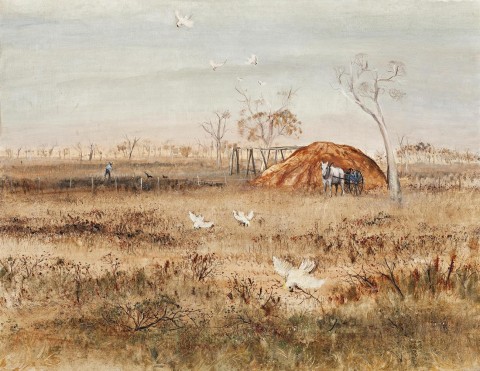WIMMERA LANDSCAPE, 1950
ARTHUR BOYD
oil and tempera on composition board
59.0 x 76.0 cm
signed lower right: Arthur Boyd
bears inscription verso: THE MACQUARIE / GALLERIES / 19 BLIGH STREET / SYDNEY
Macquarie Galleries, Sydney
Terry Clune Galleries, Sydney
David Hales, Sydney
Sotheby’s, Melbourne
Savill Galleries, Sydney, 1987 (label attached verso)
Private collection, Sydney
Savill Galleries, Sydney, 2006
Private collection, Sydney
Australian Art and Photography, Art Association Galleries, Newport, Rhode Island, USA, September 1962, cat. 19
Australian Paintings. Traditional, Modern and Contemporary, Savill Galleries, Sydney, 16 August – 23 September 2006, cat. 13 (as ‘White Cockatoos, Wimmera, c.1950’, illus. in exhibition catalogue)
Arthur Boyd: An Active Witness, Bundanon Trust touring exhibition, 23 May 2013 – 3 Jan 2016 (label attached verso)
Stanhope, Z., Arthur Boyd: An Active Witness, exhibition catalogue, Bundanon Trust, New South Wales, 2013, pp. 53 (illus.), 89 (illus.)
Wimmera Landscape, 1950, belongs to the revelatory extended sequence of paintings by Arthur Boyd inspired by a month’s residency in Victoria’s Wimmera region in the autumn of 1950. Stilled and haunting, set beneath a vast and glaring sky, these images stand in stark contrast to the red-hot paintings of Australia’s interior created earlier by Russell Drysdale, and Boyd’s future brother-in-law, Sidney Nolan. Rather, the Wimmera was close enough to Melbourne, Sydney and Canberra for its particular sense of country to be part of the lived sensibility of these otherwise metropolitan populations; and through them, Boyd ‘was showing Australians where they lived, mapping it, writing it home with his brush’.1
Born into a family of artists, Arthur Boyd became a master in a variety of media, including painting, drawing, printmaking, ceramics and ceramic sculpture. Although his imagery was populated by all forms of humanity and beasts – often imagined – Boyd’s great and enduring fascination was with landscape, dating from his earliest years painting in Rosebud alongside his artist grandfather. Widely read and deeply thoughtful, Boyd was a seemingly quiet man who nonetheless displayed a steely resolve when it came to his art. For the 1950 Wimmera expedition, the artist’s family stayed for some weeks in Horsham with Betty Bennett and her husband, the schoolteacher and poet, Jack Stevenson. Yvonne Boyd and the children went first, whilst Arthur followed ‘separately and quietly, a day or so later in the increasingly decrepit Dodge, its doors now tied up with wool-baling twine’.2
Boyd had already started experimenting with the centuries-old technique of tempera, a mixture of egg yolk, oil, water and pigment, which results in a matt, smooth surface. Extremely quick-drying, ‘the egg tempera … gave a new translucency to (Boyd’s) paintings of the late 1940s’,3 and by the time of the Wimmera trip, he was well versed in its use, and was able to harness the medium’s unique qualities for the resultant paintings, capturing in particular the baleful white light of the sky, the spiked thistles, stunted trees and scattered bird life. In Wimmera Landscape, for example, the crow-hunter’s cart and patient horse stand next to a disused ramp running out of a pile of mine tailings, both of which are slowly eroding back into the landscape. The imagery suggests a cycle of bust and renewal that the environmentalist Boyd would no doubt have been happy to convey.
Following his return, Boyd exhibited the Wimmera paintings singly and in groups in Sydney, Melbourne and Adelaide where, as one critic wrote, ‘the artist’s parched landscapes echo the spirit of the countryside’.4 Wimmera Landscape subsequently went to Newport, Rhode Island, where it formed part of an exhibition mounted as an adjunct to that year’s America’s Cup in which Australia participated for the first time with the Frank Packer-backed Gretel. In a stunning upset, Gretel won the second heat and almost claimed the fourth, causing the churlish New York Yacht Club to quickly change the rules for future races. It is tempting to wonder if the stillness of paintings like Boyd’s paintings lulled the Americans into a false sense of security, but nonetheless, images such as Wimmera Landscape would have been a revelation to local audiences, their first painterly encounter with these ‘more intimate aspects of the Australian landscape’.5
1. Bungey, D, Arthur Boyd: a life, Allen and Unwin, Sydney, 2007, p. 248
2. ibid., p. 243
3. Pearce, B., Arthur Boyd: retrospective, Beagle Press, Sydney, 1993, p. 19
4. “The Age” Art Critic, ‘New Approach by Arthur Boyd’, The Age, Melbourne, 18 September 1951, p. 2
5. Campbell, R., ‘Arthur Boyd (1920 - )’, Australia: Paintings by Arthur Streeton and Arthur Boyd, XXIX Biennale, Venice, 1958, unpaginated
ANDREW GAYNOR
